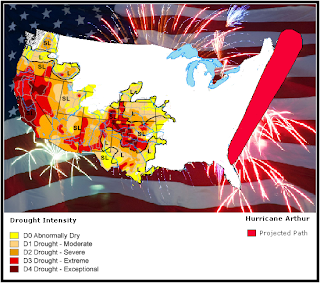Fireworks are a longstanding tradition for Independence Day, however, they are being curtailed due drought and extreme weather this Fourth of July holiday. These factors have muted or canceled pyrotechnical displays in the Southwest and along the East Coast. It is widely accepted that climate change can exacerbate both droughts and hurricanes.
Drought
With California, Texas, New Mexico, Arizona, and Utah suffering from drought, parts of these states have restricted the use of some fireworks. Warmer temperatures associated with climate change can increase evapotranspiration which can produce droughts.
According to the EPA during the period from 2000 through 2013, roughly 20 to 70 percent of the US land area experienced conditions that were at least abnormally dry. In 2012, the US experienced the driest conditions in more than a decade. During the latter half of 2012, more than half of the U.S. land area was covered by moderate or greater drought. In several states, 2012 was among the driest years on record this was particularly true in the Southwest.
According to the National Fire Protection Association, pyrotechnics account for two out of five reported fires on July 4 in the US. This is more than any other single cause. In California wildfires are already burning at a level which is 70 percent above average. In an effort to clamp down on illegal fireworks, California has confiscated 300,000 pounds of pyrotechnics ahead of Independence Day.
In places where certain types of fireworks are permitted, officials are urging caution and asking residents to limit their use. This is a serious blow to the 1 billion US pyrotechnical industry.
Hurricane Arthur
While party goers in the South and West will see less fireworks due to drought this Independence Day, those along parts of the East coast are having their pyrotechnical celebrations interrupted by Hurricane Arthur.
Arthur is the first Hurricane of the year, it was categorized as a level 2 hurricane on Thursday night bringing with it sustained winds of 96-110 mph. Arthur made landfall at 11:15 p.m. EDT Thursday, over the Shackleford Banks which is located between Cape Lookout and Beaufort, North Carolina. The hurricane's northeasterly path takes it along the Atlantic coast starting on Thursday night and ending on Saturday. A coastal inundation (storm surge plus astronomical tides) of 3 to 6 feet of water is forecast in some areas.
Hurricanes are fueled by warm ocean water plus the Earth's eastward rotation. As the earth warms the oceans, the risks of hurricanes increase.
"They're heat engines," said meteorologist Jeff Masters of the website Weather Underground. "They take heat from the oceans and convert it to the energy of their winds. They're taking thermal energy and making mechanical energy out of it."
A September 2005, paper (Webster et al., 2005), titled "Changes in Tropical Cyclone Number, Duration, and Intensity in a Warming Environment", reported that worldwide, the number of Category 4 and 5 hurricanes had increased 80 percent in the past 30 years. The study linked the rise in storms to increasing sea surface temperatures and concluded that "global data indicate a 30-year trend toward more frequent and intense hurricanes."
The NOAA's GFDL division predicts that anthropogenic warming will likely cause hurricanes to be more intense and more common by the end of the 21st century.
The threat of severe weather prompted officials in Boston to move the traditional July Fourth celebrations up one day. A storm cut short the festivities of the 41st annual Boston Pops Fireworks Spectacular on July 3rd.
Rather than stage them early, Ocean City postponed their fireworks display by one day because of Hurricane Arthur.
This Independence Day we are forced to acknowledge that climate change has wide ranging affects which can even include pyrotechnical restrictions on America's birthday.
- Blogger Comment
- Facebook Comment
Subscribe to:
Post Comments
(
Atom
)

0 comments:
Post a Comment